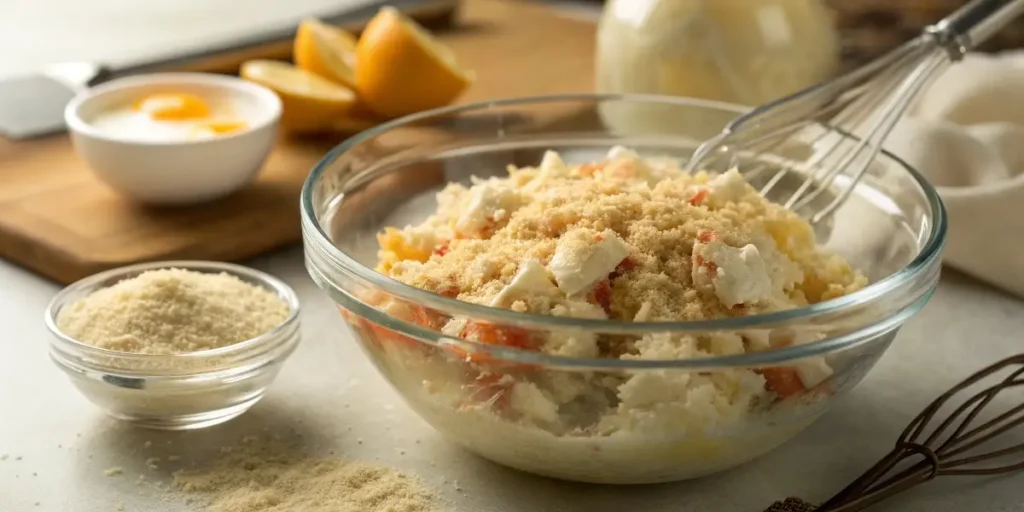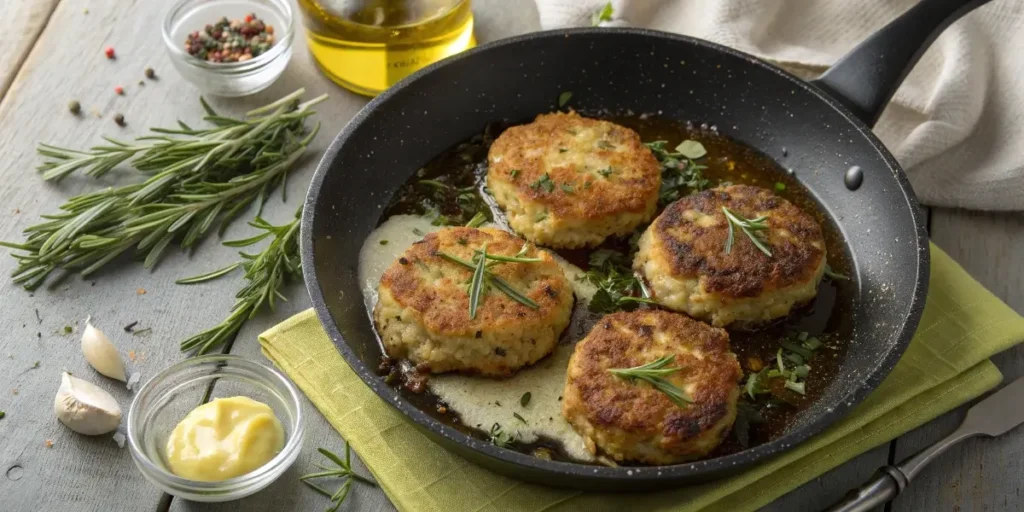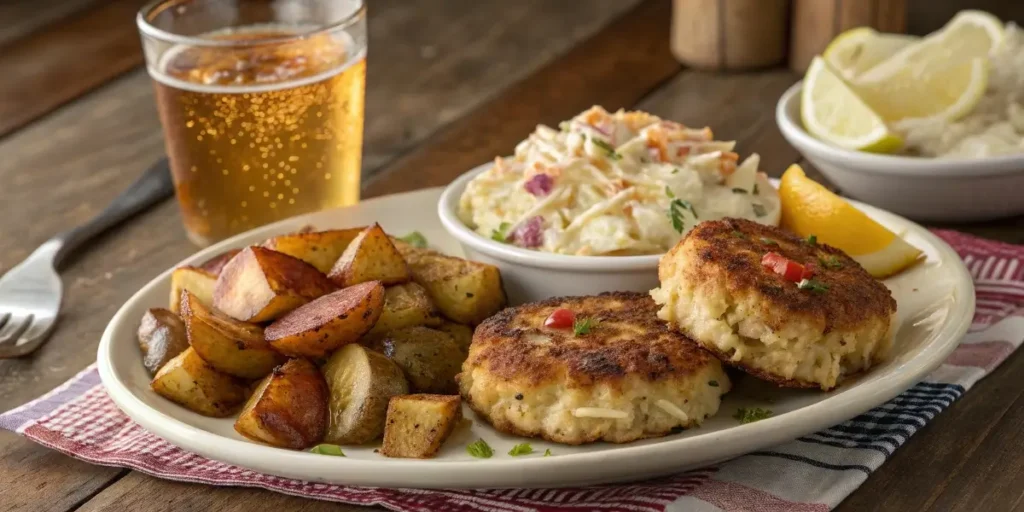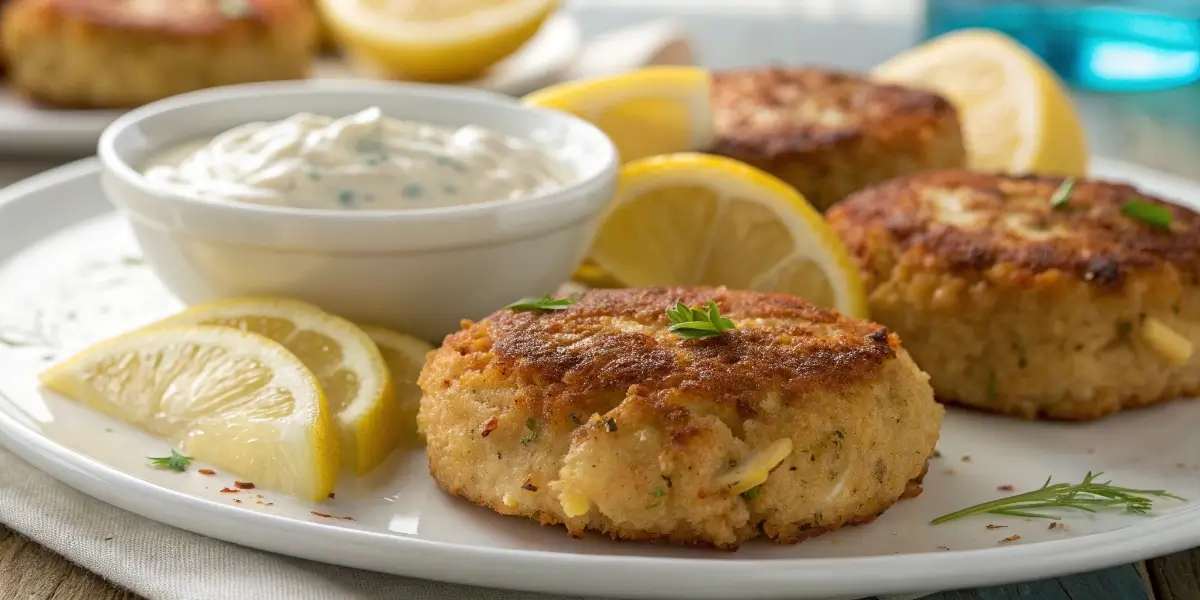Best Dungeness Crab Cake Recipe for Crispy, Flavorful Perfection
Nothing says coastal comfort quite like a Dungeness crab cake recipe made from sweet, tender crab meat and golden-brown crust. Whether served as an elegant appetizer or a main course, these crab cakes bring a delicate balance of texture and flavor that truly celebrates the Pacific Coast’s culinary charm. In this guide, you’ll learn how to select the best crab, create the perfect blend of ingredients, and master the techniques for restaurant-quality results right at home. Learn more about other seafood favorites in our delicious salmon cakes and seafood salad recipe for extra inspiration.
Table of Contents
Introduction to the Dungeness Crab Cake Recipe
Why Dungeness Crab Makes the Best Crab Cakes
When it comes to making the best crab cakes, Dungeness crab stands out as the premium choice. Harvested primarily from the cold waters of the Pacific Northwest, its meat is known for its sweet, buttery flavor and tender texture that holds beautifully when formed into cakes. The natural sweetness of Dungeness crab complements a range of seasonings — from Old Bay to lemon zest — allowing for a dish that’s both simple and sophisticated.
Unlike other varieties such as blue crab, Dungeness crab offers large, flaky chunks that give crab cakes a luxurious, hearty feel. Because the meat is less briny and more delicate, it blends seamlessly with breadcrumbs and light binders without losing its natural taste. For those who love rich seafood flavor with a soft, melt-in-your-mouth bite, this is the crab to use.
Looking for another flavorful seafood treat? Check out our bang bang shrimp recipe for a crispy, spicy alternative that complements crab dishes perfectly.
History and Origin of Dungeness Crab Cakes
The Dungeness crab cake recipe has deep roots in coastal cuisine. Originating from the Pacific Northwest, this dish draws influence from both classic East Coast crab cakes and regional West Coast seafood traditions. Fishermen along the Oregon and Washington coasts often prepared fresh-caught crab mixed with breadcrumbs, herbs, and eggs to create a satisfying, protein-rich meal after long days on the water.
Over time, Dungeness crab cakes became a symbol of local pride — a dish served in seaside restaurants and gourmet kitchens alike. Today, home cooks across America replicate this recipe to bring a touch of the ocean to their tables. The balance of sweet crab meat, tangy lemon, and crisp coating has made it a timeless favorite for seafood lovers.
Don’t miss our garlic shrimp gratin for another coastal-inspired recipe that brings creamy seafood flavor to your table.
Selecting the Best Dungeness Crab Meat
Fresh vs. Canned Dungeness Crab: Which to Choose
When preparing a Dungeness crab cake recipe, the quality of your crab meat determines everything—from texture to flavor. While fresh crab meat reigns supreme for its sweetness and firm chunks, canned Dungeness crab is a convenient backup that still delivers excellent results if handled properly.
Fresh Dungeness crab offers that unmistakable ocean-fresh taste with naturally moist, flaky meat. If you can get live or freshly cooked crab from a seafood market, that’s ideal. Look for bright white meat with no fishy odor, and avoid crab that seems mushy or discolored.
On the other hand, canned crab is a practical option for quick meals. Always drain it well and gently pat it dry to prevent excess moisture, which can make crab cakes fall apart during cooking. For a little texture boost, try mixing half fresh and half canned crab meat—it creates a perfect balance of flavor and convenience.
Discover great ideas like our king salmon recipe for another Pacific Northwest favorite that pairs beautifully with Dungeness crab cakes.
How to Prepare and Clean Dungeness Crab for Cooking
If you’re starting with whole Dungeness crabs, proper preparation is key. Begin by cooking the crab in salted boiling water for about 15 minutes, or until the shell turns bright orange. Let it cool slightly, then remove the top shell and discard the gills and internal organs. Crack the claws and legs to extract the sweet, white meat.
You’ll want to separate the body meat, which is softer and more delicate, from the claw and leg meat that has a firmer bite. Gently inspect the meat for shell fragments before using it in your crab cake mixture. The fresher the crab, the less seasoning it needs—just a bit of lemon juice, salt, and pepper can make its natural sweetness shine.
If you prefer a full seafood spread, check out our delicious crab brulee recipe — a creative way to impress guests with coastal-inspired dishes.
Essential Ingredients for a Perfect Dungeness Crab Cake Recipe
Key Ingredients That Define the Flavor
The secret behind a truly memorable Dungeness crab cake recipe lies in choosing high-quality ingredients that complement the sweet, delicate taste of the crab. Every component plays a role in balancing moisture, texture, and richness.
Here’s what you’ll need:
| Ingredient | Purpose | Pro Tip |
|---|---|---|
| Dungeness Crab Meat | Main ingredient, offers sweetness and flaky texture | Use fresh, hand-picked crab for best results |
| Breadcrumbs (panko or regular) | Binder and crispiness enhancer | Lightly toast before mixing for extra crunch |
| Mayonnaise | Adds creaminess and moisture | Use real mayo, not salad dressing |
| Egg | Helps hold the cakes together | One egg per pound of crab works perfectly |
| Dijon Mustard | Boosts flavor depth | Adds tang without overpowering crab |
| Old Bay Seasoning | Classic seafood spice | Use sparingly to avoid masking crab flavor |
| Lemon Juice | Brightens and balances flavor | Always use freshly squeezed lemon |
| Fresh Parsley | Adds freshness | Finely chop to distribute evenly |
When combined properly, these ingredients create the ideal balance of flavor and structure. The breadcrumbs and egg ensure stability, while lemon juice and Dijon mustard elevate the crab’s sweetness.
For those who love bold flavor, add a pinch of cayenne or smoked paprika for a subtle heat that won’t overpower the delicate crab.
Looking for inspiration? Try our delicious smoked salmon brine recipe to bring another seafood classic to your menu.
Substitutions and Add-Ins for Custom Taste
Personalizing your Dungeness crab cake recipe is easy. The mild flavor of Dungeness crab pairs beautifully with herbs and subtle spices. Instead of breadcrumbs, you can use crushed saltine crackers for a lighter texture. For a gluten-free version, opt for almond flour or crushed rice crackers.
Want a little extra kick? Add diced jalapeños or a touch of hot sauce to the mix. You can also fold in finely chopped bell peppers, green onions, or celery for extra crunch. If you prefer a richer taste, a small amount of melted butter can make the mixture even more indulgent.
For an elegant twist, pair your crab cakes with a citrus aioli or roasted red pepper sauce—both enhance the sweetness of Dungeness crab without overshadowing it.
Don’t miss our halibut taco recipe and garlic parmesan chicken pasta for more coastal and creamy seafood meal ideas.
Step-by-Step Dungeness Crab Cake Preparation

Mixing the Perfect Crab Cake Batter
Creating the ideal texture in your Dungeness crab cake recipe comes down to gentle handling and the right ratio of ingredients. You want the mixture to hold together without being dense or overly wet. Start by whisking together the mayonnaise, Dijon mustard, lemon juice, egg, and seasonings in a large bowl. This forms the creamy base that binds the crab meat and crumbs.
Next, fold in the Dungeness crab meat and breadcrumbs gently. Use a spatula instead of a spoon to avoid breaking up the delicate crab lumps. Aim for a mixture that feels slightly sticky but not soggy — it should form soft, round cakes that hold shape when pressed lightly.
For a light crunch, use panko breadcrumbs; for traditional East Coast-style crab cakes, stick with fine breadcrumbs. If the mixture feels too wet, add a tablespoon of breadcrumbs at a time until it firms up. Avoid overmixing, as it can make the cakes dense.
Discover great seafood blends like our seafood salad recipe to serve alongside your crab cakes for a complete meal.
Shaping and Chilling Crab Cakes for Best Texture
Once your mixture is ready, scoop about ⅓ cup per cake and gently form patties about one inch thick. The key to achieving that restaurant-quality crispness is chilling the crab cakes before cooking. Place them on a parchment-lined tray and refrigerate for at least 30 minutes. This helps the binders set and prevents them from falling apart during frying or baking.
For an extra firm texture, you can freeze the crab cakes for 10 minutes before cooking. When ready to cook, coat each cake lightly in panko crumbs for a golden exterior.
If you’re prepping ahead, these crab cakes can be refrigerated for up to 24 hours before cooking. They’re also freezer-friendly — just store them between wax paper layers in an airtight container.
Check out our crispy juicy chicken cutlets for another dish that relies on the same chilling and crisping techniques for perfect texture every time.
Cooking Techniques for Dungeness Crab Cakes
Pan-Frying vs. Baking: Which Is Better?
One of the most common questions when preparing a Dungeness crab cake recipe is whether to fry or bake them. The answer depends on your desired texture and health preference.
Pan-frying delivers that golden, crispy crust most people crave. Heat a nonstick skillet over medium-high heat and add a thin layer of oil or butter. Once hot, place your chilled crab cakes in the pan and cook for about 3–4 minutes per side, until each side turns a rich golden brown. This method locks in moisture and gives the cakes a satisfying crunch.
If you prefer a lighter, healthier version, baking is a great alternative. Preheat your oven to 400°F (200°C) and place crab cakes on a lightly oiled baking sheet. Bake for 15–18 minutes, flipping halfway through for even browning. Baking uses less oil and ensures a consistent cook throughout, making it ideal for larger batches or meal prep.

Want another oven-baked seafood idea? Don’t miss our baked whole tilapia — a simple, wholesome dish that highlights natural fish flavor just like crab cakes do.
Tips for Achieving Crispy Golden Crab Cakes
The best Dungeness crab cake recipe achieves that perfect crunch-to-softness ratio. Here’s how to make it happen every time:
- Use chilled crab cakes – Cold cakes hold their shape better and fry more evenly.
- Avoid overcrowding the pan – Cook in batches to maintain oil temperature and crispness.
- Use the right oil – Light oils like canola or avocado handle high heat without burning.
- Add butter near the end – A pat of butter in the last minute adds flavor and rich color.
- Drain on paper towels – This removes excess oil for a clean, golden finish.
For an extra restaurant-quality touch, finish the cakes with a squeeze of lemon juice and a sprinkle of sea salt. Serve immediately while hot for the best texture.
Learn more about great seafood ideas like our delicious teriyaki salmon or bang bang salmon bites to complement your meal with more coastal flavors.
Making the Perfect Sauce to Serve with Dungeness Crab Cakes
Classic Remoulade and Tartar Sauce Variations
Every Dungeness crab cake recipe deserves a standout sauce. While the crab’s natural sweetness shines on its own, the right condiment adds balance and excitement to every bite. Two classic choices—Remoulade and Tartar Sauce—are beloved for a reason.
Remoulade Sauce brings a tangy, slightly spicy touch that cuts through the richness of the crab. Here’s a simple yet flavorful version:
- ½ cup mayonnaise
- 2 teaspoons Dijon mustard
- 1 teaspoon hot sauce
- 1 tablespoon finely chopped capers
- 1 tablespoon lemon juice
- 1 teaspoon smoked paprika
Mix all ingredients until smooth, then chill before serving. The smoky, tangy flavor enhances the delicate Dungeness crab without overpowering it.
Tartar Sauce, on the other hand, offers a creamy, citrusy bite that feels refreshing. Combine:
- ½ cup mayonnaise
- 1 tablespoon dill pickles (finely chopped)
- 1 tablespoon lemon juice
- 1 teaspoon dried dill
- Salt and pepper to taste
This sauce pairs perfectly with baked crab cakes and is excellent for dipping fries or grilled fish, too.
For another creamy seafood pairing, learn more about our creamy vegan hollandaise sauce — it’s a plant-based option that complements crab cakes beautifully.
Spicy and Creamy Sauce Options for a Twist
If you’re craving something bold, try giving your Dungeness crab cake recipe a modern twist with spicy and global-inspired sauces.
Sriracha Aioli: Mix ½ cup mayonnaise, 2 tablespoons Sriracha, 1 teaspoon garlic powder, and a splash of lime juice. The heat balances the crab’s sweetness perfectly.
Cajun Cream Sauce: Combine ½ cup sour cream, 1 tablespoon Cajun seasoning, and 1 teaspoon lemon juice. This Southern-inspired blend adds smoky heat and pairs beautifully with fried crab cakes.
Avocado Lime Crema: Blend one ripe avocado with Greek yogurt, lime juice, and a pinch of salt for a fresh, zesty twist that’s ideal for summer crab cake sliders.
Check out our mango sago recipe for a cool, tropical dessert that follows these zesty crab cakes perfectly.
Serving and Pairing Ideas for Dungeness Crab Cake Recipe
Side Dishes That Complement Crab Cakes
A great Dungeness crab cake recipe shines even more when paired with the right sides. You want accompaniments that complement the crab’s sweetness without stealing the spotlight. Light, fresh sides with bright flavors or a bit of crunch tend to work best.
Try these perfect pairings:
| Side Dish | Description | Why It Works |
|---|---|---|
| Coleslaw with Lemon Dressing | A crisp, tangy mix of cabbage, carrots, and lemon vinaigrette | Cuts through richness with refreshing crunch |
| Roasted Baby Potatoes | Tossed in olive oil, garlic, and herbs | Adds comfort and substance |
| Corn on the Cob | Brushed with butter and paprika | Sweet flavor complements crab perfectly |
| Steamed Asparagus | Lightly seasoned with lemon zest | Keeps the plate elegant and balanced |
| Mixed Green Salad | Greens, tomatoes, cucumbers, and vinaigrette | A refreshing touch for a seafood dinner |
For a twist, try serving crab cakes over garlic mashed potatoes or alongside grilled vegetables for a bistro-style presentation.

Don’t miss our cabbage kielbasa soup recipe or creamy succotash recipe for side options that make your meal heartier without overpowering the crab.
Storing and Reheating Dungeness Crab Cakes
Best Storage Practices for Freshness
After preparing your Dungeness crab cake recipe, proper storage ensures that you maintain both flavor and texture. Whether you’ve made extra for later or are planning ahead for a party, freshness is key.
For refrigeration, place cooked crab cakes in an airtight container lined with parchment paper. Layer them with wax or parchment sheets to prevent sticking. Store in the refrigerator for up to 3 days. This method preserves the tender crab meat without drying it out.
If you’re storing uncooked crab cakes, refrigerate them for up to 24 hours before cooking. Always cover them tightly to keep out moisture and odors from other foods.
For longer storage, freezing is your best option. Place the uncooked or cooked crab cakes on a baking sheet, freeze until solid (about 1 hour), then transfer them into freezer-safe bags. Label them with the date and store for up to 3 months.
Check out our funeral potatoes recipe for another make-ahead comfort food that stores and reheats beautifully, just like crab cakes.
How to Reheat Without Losing Texture
Reheating your Dungeness crab cake recipe properly makes all the difference. You want to revive the crisp outer crust while keeping the inside moist and tender.
Oven Method (Best for Crispness):
- Preheat oven to 375°F (190°C).
- Place crab cakes on a parchment-lined baking sheet.
- Bake for 10–12 minutes, flipping halfway through for even heat.
Skillet Method (Quick and Crispy):
- Heat a tablespoon of oil in a nonstick pan over medium heat.
- Add crab cakes and cook for 3 minutes per side, just until warmed through.
Air Fryer Method (Best for Leftovers):
- Set air fryer to 370°F (185°C).
- Cook for 6–7 minutes, shaking once halfway through.
Avoid microwaving — it can make the crab cakes soggy and rubbery. If you must use a microwave, reheat on low for a minute and finish crisping in a pan.
Learn more about seafood recipes like our baked orange roughy recipe — another delicate fish dish that reheats perfectly with the same care.
Common Mistakes and Expert Tips
What Causes Crab Cakes to Fall Apart?
Even the most experienced cooks can run into issues when preparing a Dungeness crab cake recipe, especially when the cakes fall apart during cooking. Understanding why this happens ensures consistently beautiful results.
Here are the main culprits:
- Too Much Moisture: Overly wet crab meat or too much mayo can cause cakes to crumble. Always drain canned crab thoroughly and pat it dry with paper towels.
- Not Enough Binder: Eggs and breadcrumbs work together to hold the cakes together. Stick to one egg per pound of crab and adjust breadcrumbs as needed for firmness.
- Skipping the Chill Step: If you skip chilling, the mixture may fall apart when heated. Always refrigerate for at least 30 minutes before cooking.
- Rough Handling: Dungeness crab meat is delicate — handle it gently when mixing and flipping. Use a spatula and avoid pressing too hard.
Want to see another seafood classic that relies on balance and technique? Check out our delicious salmon cakes — they share the same flaky, crisp perfection that makes crab cakes irresistible.
Chef-Approved Tricks for the Perfect Crab Cake
Professional chefs rely on subtle tweaks to elevate a Dungeness crab cake recipe from good to gourmet. These tips can help you achieve that same restaurant-quality flavor at home.
- Use Fresh Lemon Zest: A little zest enhances natural sweetness and adds aroma.
- Incorporate a Mix of Crab Textures: Combine claw and body meat for balanced flavor and structure.
- Pre-toast Breadcrumbs: Toasting gives extra crunch and nutty flavor.
- Add a Dash of Worcestershire or Hot Sauce: Small amounts bring depth without overpowering.
- Cook in Butter and Oil: A mix of both ensures golden color and rich taste.
When plating, serve with a dollop of sauce, a lemon wedge, and a light garnish of microgreens or chives for a clean, elegant presentation.
Discover more coastal recipes like our halibut cheeks recipe and peruvian chicken recipe — they’re great additions to your dinner rotation and highlight the same balance of texture and seasoning that makes crab cakes shine.
Conclusion
Crafting the perfect Dungeness crab cake recipe is all about balance — fresh ingredients, gentle handling, and precise technique. Dungeness crab’s naturally sweet and buttery flavor makes it the star of any seafood dish, and with the right blend of breadcrumbs, seasonings, and cooking method, you can easily recreate restaurant-quality crab cakes at home. Whether pan-fried to a golden crisp or baked for a lighter touch, each bite captures the true essence of coastal cuisine.
For a full seafood experience, pair your crab cakes with light sides like lemon coleslaw or roasted veggies, and finish with a refreshing tropical drink. With these expert tips, your Dungeness crab cakes will always come out tender, flavorful, and perfectly crisp.
Looking for inspiration? Try our seafood salad recipe or garlic shrimp gratin to expand your seafood repertoire with complementary coastal favorites.
FAQs
Is Dungeness crab good for crab cakes?
Absolutely. Dungeness crab is one of the best varieties for crab cakes because of its sweet, mild flavor and large, tender flakes. Its meat binds easily without turning mushy, creating a rich texture that’s both juicy and delicate. Compared to blue crab, Dungeness offers a cleaner, buttery taste perfect for showcasing in gourmet-style crab cakes.
What is the secret to good crab cakes?
The secret lies in balance — using just enough binder to hold the crab together without overwhelming its flavor. Always use fresh Dungeness crab, minimal filler, and chill the cakes before cooking. Gentle handling is crucial. A light sear in butter and oil creates a crisp exterior with a soft, flavorful center.
What holds crab cakes together?
A combination of egg and breadcrumbs acts as the binder in a classic Dungeness crab cake recipe. The egg gives structure, while breadcrumbs absorb excess moisture. Too little binder makes the cakes fall apart; too much results in a dense texture.
What kind of crab meat is best for crab cakes?
Fresh Dungeness crab meat is ideal for its flaky texture and sweet, buttery flavor. If you can’t find it fresh, use canned Dungeness crab packed in water (not brine). Lump meat from the claws and body offers the best texture for binding and presentation.
Is it better to fry or bake crab cakes?
Both methods work well, but frying delivers the crispiest crust, while baking offers a lighter, healthier version. Pan-frying in a mix of butter and oil for 3–4 minutes per side provides that restaurant-style crunch. Baking at 400°F for 15–18 minutes ensures even cooking without extra oil.
What is the best binder for crab cakes?
The best binders are egg and mayonnaise. The egg provides structure, while mayo adds richness and moisture. For gluten-free versions, swap breadcrumbs for almond flour or crushed rice crackers — they bind beautifully while keeping the cakes light and crisp.

